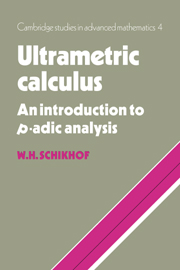Summary
From now on we shall use the following conventions. Unless stated explicitly otherwise we have
K IS A COMPLETE NON-ARCHIMEDEAN NON-TRIVIALLY VALUED FIELD WITH RESIDUE CLASS FIELD k
THE CHARACTERISTIC OF A FIELD L IS char (L)
p IS A PRIME NUMBER
x = Σnanpn FOR A p-ADIC NUMBER x DENOTES THE STANDARD EXPANSION OF x (see Section 5)
IF char(K) = 0, char(k) = p THEN THE VALUATION IS CHOSEN SUCH THAT ℝp IS A VALUED SUBFIELD OF K. THE VALUATION ON ℂp IS DENOTED │ │p
LET K HAVE A DISCRETE VALUATION. THEN π ∈ K IS AN ELEMENT SUCH THAT │φ│ = max │K×│ ∩ (0, 1)
PART 1: ELEMENTARY CALCULUS
In Chapter 2 we shall develop the first principles of ultrametric calculus. Our main interest lies in calculus over ℚp and ℂp.
The classical concepts of calculus
This section is not very exciting. We shall list notions and statements that are directly borrowed from the classical analysis over ℝ and ℂ, some of which have been used already implicitly in Chapter 1. Starting with the next section the story of ultrametric calculus is going to diverge from the ‘classical’ one and shall become more interesting. No proofs are given; in case of any doubt the reader may supply one as an exercise.
Recall that our assumption that K is complete means that every Cauchy sequence in K converges. A sequence a1, a2, … in K converges to an element a ∈ K if limn → ∞ │a − an│ = 0.
- Type
- Chapter
- Information
- Ultrametric CalculusAn Introduction to p-Adic Analysis, pp. 56 - 144Publisher: Cambridge University PressPrint publication year: 1985



